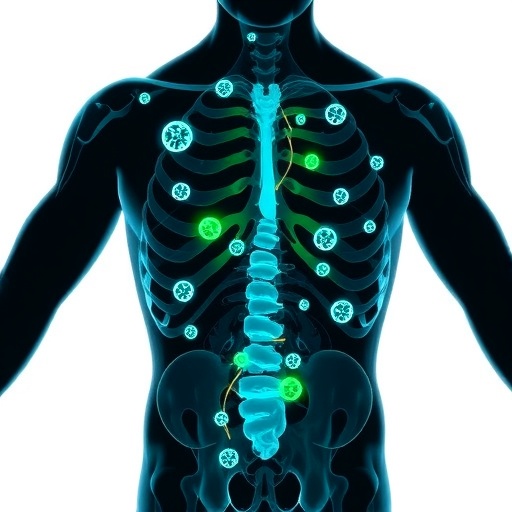In the ever-evolving landscape of medical research, recent findings have highlighted the pivotal role of GPER (G-protein-coupled estrogen receptor) in the intricate web of metabolic homeostasis and its implications in various diseases. The groundbreaking study conducted by Liu, Zhou, Liu, and colleagues delves into the molecular mechanisms by which GPER functions, its nutritional regulation, and its enormous therapeutic potential. This research is not merely academic but holds the promise of reshaping our understanding and treatment of metabolic disorders.
At the core of this investigation lies the acknowledgment that metabolic diseases, such as obesity, diabetes, and cardiovascular conditions, are increasingly prevalent in today’s society. With lifestyle changes contributing to the surge in these conditions, understanding the underlying biological mechanisms has become essential. GPER operates as a key player in the endocrine signaling pathways, influencing both metabolic processes and overall homeostasis. Liu et al. meticulously outline how GPER activation can modulate glucose metabolism and adipocyte function, thus presenting an exciting avenue for therapeutic intervention.
What makes GPER particularly compelling is its dual role in both the central nervous system and peripheral tissues. This receptor is integrated into pathways that govern energy balance, suggesting that its manipulation could lead to innovative treatments for weight management and obesity-related complications. The authors present evidence indicating that GPER agonists can stimulate thermogenesis in brown adipose tissue, thus increasing energy expenditure. This discovery poses GPER as a potential target for drug development aimed at tackling obesity.
Furthermore, the nutritional regulation of GPER is an intriguing aspect of the study that warrants attention. Liu and colleagues emphasize that dietary components play a significant role in modulating GPER activity. For instance, phytoestrogens found in various plants can interact with GPER and enhance its signaling pathways, leading to improved metabolic outcomes. This insight bridges nutrition and pharmacology, suggesting that dietary interventions could complement pharmacological strategies in managing metabolic diseases.
The therapeutic potential of targeting GPER extends beyond metabolic disorders. The study indicates that GPER may possess anti-inflammatory properties, which could be beneficial in conditions like cardiovascular disease and metabolic syndrome. Chronic inflammation is a common denominator in many chronic diseases, and the ability of GPER to modulate inflammatory pathways presents an opportunity for novel therapeutic approaches. The prospect of using GPER agonists to reduce inflammation and improve metabolic outcomes is a tantalizing avenue for future research.
In addition, Liu et al. explore the implications of GPER signaling in insulin sensitivity. Insulin resistance is a hallmark of metabolic diseases, particularly type 2 diabetes. The findings suggest that GPER activation may enhance insulin action in tissues such as skeletal muscle and liver, thereby improving glucose homeostasis. This relationship between GPER signaling and insulin sensitivity is crucial, as it provides a potential mechanism by which GPER modulators could help reverse the pathological processes underlying type 2 diabetes.
The study also raises interesting questions about gender differences in GPER function. Given that metabolic diseases often exhibit sex-specific prevalence and presentation, understanding how GPER operates differently in men and women could lead to more tailored therapeutic strategies. Research indicates that hormonal factors may modulate GPER activity, thus necessitating further investigation into the role of sex hormones in the regulation of metabolic processes via GPER.
Furthermore, the potential for GPER to act as a biomarker for disease progression is another exciting aspect highlighted in the study. Levels of GPER expression might correlate with the severity of metabolic disorders, suggesting that monitoring its activity could inform treatment decisions. This could pave the way for personalized medicine approaches, where therapies are adjusted based on individual GPER activity profiles.
As researchers continue to unravel the complexities of GPER’s role in metabolism, the implications for public health are profound. Given the global rise in obesity and metabolic disorders, there is an urgent need for innovative strategies that address the root causes of these conditions. Targeting GPER may offer a new paradigm in preventive and therapeutic healthcare, moving beyond traditional methods towards more comprehensive and effective solutions.
Moreover, the study encourages interdisciplinary collaboration, merging insights from endocrinology, nutrition, and pharmacology. By fostering partnerships between these fields, researchers can create more integrated approaches to address the multifaceted nature of metabolic diseases. The insights gleaned from Liu et al.’s research could inspire a wave of new studies aimed at harnessing the power of GPER in various therapeutic contexts.
In summary, Liu, Zhou, Liu, and their team’s exploration of GPER in the context of metabolic homeostasis and disease signifies a meaningful advancement in our understanding of metabolic health. Their work elucidates the complex interactions between molecular signaling pathways, dietary influences, and therapeutic possibilities. As we seek to combat the escalating crisis of metabolic disorders, the findings surrounding GPER stand out as a potential beacon of hope—a path leading towards innovative treatments and enhanced quality of life for those affected by these conditions.
In conclusion, the ongoing research into GPER opens doors to novel therapeutic strategies that may one day become staples of clinical practice. As scientists continue to tease apart the intricate relationships within metabolic pathways, the realization that GPER is a critical component provides a new lens through which we can view treatment options. The excitement surrounding this research, coupled with its potential to drive real-world changes, underscores the importance of continued exploration into the role of GPER in metabolic health.
Subject of Research: GPER in metabolic homeostasis and disease
Article Title: GPER in metabolic homeostasis and disease: molecular mechanisms, nutritional regulation, and therapeutic potential
Article References:
Liu, L., Zhou, Y., Liu, J. et al. GPER in metabolic homeostasis and disease: molecular mechanisms, nutritional regulation, and therapeutic potential. J Transl Med 23, 960 (2025). https://doi.org/10.1186/s12967-025-07005-0
Image Credits: AI Generated
DOI:
Keywords: GPER, metabolic homeostasis, obesity, diabetes, inflammatory pathways, insulin sensitivity, nutritional regulation, therapeutic potential




